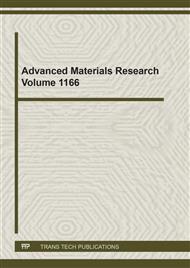p.13
p.25
p.33
p.41
p.57
p.65
p.81
p.95
p.113
Numerical Simulation on Dynamic Fracture of Glass Plate Fitted with Polymeric Film
Abstract:
The impact resistance improvement is important for window glass to protect people from injury. Although it has been proved that the impact resistance of a glass plate can be improved easily by fitting a thin polymeric film, its mechanism has not been clarified yet. The purpose of this study is to clarify the reinforcing mechanism of the impact resistance of a glass plate by fitting a polymeric film. To clarify it, a numerical simulation model was built using ANSYS Autodyn to simulate the dynamic fracture of a glass plate fitted with a polymeric film. The simulation model and results were examined by comparing them to the experimental result in the previous study. The Johnson-Holmquist (JH2) damage model was used for the constitutive law of the glass plate. A polymeric film with 0.2 mm thickness (3% with the glass plate) was modeled at the non-impact surface of the glass plate. The nodes of the glass plate at the interface with the film connected the nodes of the film by perfect bonding. By comparing the simulation results to the experiment, it was indicated the importance of modeling the remaining fragments of the glass plate and the adhesive layer of the film in simulating the dynamic fracture of the glass plate fitted with polymeric film.
Info:
Periodical:
Pages:
57-64
Citation:
Online since:
September 2021
Authors:
Keywords:
Price:
Сopyright:
© 2021 Trans Tech Publications Ltd. All Rights Reserved
Share:
Citation:


